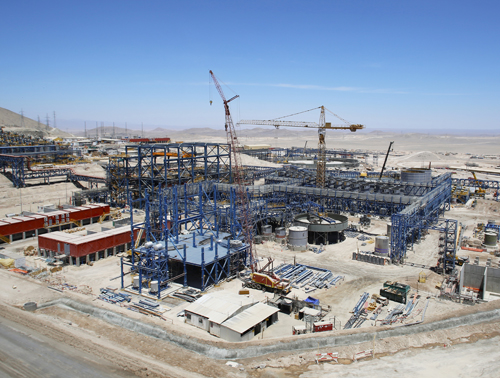
As Joseph Tis, Senior Vice President, explains, 2013 was an important year for the Sierra Gorda open pit copper mine project. “In February of last year the project budget, valued at $4,000 million was updated. In the months that followed the project went on to complete a consolidated advance of 52.9 percent, reaching 91.2 percent in February 2014.”
Located within Northern Chile’s Atacama Desert, the Sierra Gorda Project is a joint venture between KGHM International Ltd, Sumitomo Metal Mining and Sumitomo Corporation, and possesses deposits that total up to 2.2 billion tonnes of measured and indicated resources, and reserves amounting to some 1.3 billion tonnes.
In addition to completing detailed engineering and locking down the purchasing of equipment, 2013 also saw Sierra Gorda benefit from the completion of infrastructure works designed to supply the site with electricity and water. Both 110Kv and 220kV electricity lines are now positioned on site, with the 110kV line going live during March of this year and the 220kV being brought into action the following month. In addition to the completion of these power lines, the assembly and welding of the project’s sea water aqueduct has also been finished.
A particularly striking example of the progress made at Sierra Gorda over the last 12-18 months comes in the form of the project’s processing plant. “We have made a number of great advances in the construction plant over the last year or more,” Tis agrees, “going from eight to twelve percentage points during the months between August and December 2013 alone. Particular milestones achieved during 2013 included the delivery of the Truck Shop to operations, delivery of shovels 4 and 5, and the delivery of 17 haul trucks for use in pre-stripping extraction operations. Furthermore, 2013 saw the installation of all critical plant equipment.”
Tis is keen to add that all of the achievements already mentioned have been as a result of the tireless work of the project’s workforce performed in the field. During the month of October, 2013, employment activity on site reached a peak of 9,500 workers, while 2013 as a whole saw a total of 11,236,934 man hours earned.
“As of January 2014, we have calculated that more than 44,000 people have directly contributed to the construction of the project and its various elements,” Tis states. “Each and every one of these people have at all times remained committed to our “Zero Harm” ethos, our most fundamental value which enforces our commitment to the health and safety of our employees and the communities in which we operate, and in doing so have not only met, but often exceeded expectations.”
As a company KGHM has long been proud of the fact that it acts as a major contributor towards employment generation, regardless of where it is based. This is very much the case with the Sierra Gorda Project, what with a great many of the 44,000 people who have contributed to its development coming from regions surrounding it. The largest contributor to date has been the VIII Biobío Region, from which the project has employed some 9,557 people, or 21.6 percent of the 44,000. Other major contributors have been the II Antofagasta Region, the Santiago Metropolitan Region XIII and the V Valparaíso Region, with 7,505, 7,085 and 6,306 residents employed on the project respectively. On top of these figures, no fewer than eleven other regions, from the XV Region of Arica and Parinacota, through to the XII Region of Magallanes have also contributed employees to the project.
In addition to the creation of jobs, the Sierra Gorda Project has also contributed in other vital ways to the local and national economies of Chile. “The existence of this project has not only helped strengthen the local mining industry, but also will contribute to the increased supply of copper on a national and international scale,” Tis says. “In doing so we have also played our part in ensuring that the country remains a leading global player when it comes to the production of copper, and in showcasing the professional quality and expertise of workforce, taking a massive development project from start to finish, we have helped send out a message to investors that Chile is a country worth taking notice of.”
Giving back to the community is a trait that in many ways has characterised the project since its inception. To this day this arguably remains best reflected in the development, construction and implementation of numerous infrastructure projects that have helped improve quality of life within the region. Such projects include the construction of a wastewater treatment plant, the expansion of security checkpoints and the installation of CCTV to provide a safer environment, and the implementation of programmes designed to protect native flora and fauna.
While 2013 was certainly an important year for the Sierra Gorda, 2014 could prove to be an even greater milestone, what with production at its processing plant due to commence this year, thus ushering in a new phase for the project. “In the short term our efforts are very much focused on completing the construction and pre-commissioning phases of the processing plant, and subsequently bringing it online, all the while fulfilling our Zero Harm commitments” Tis concludes. “Throughout the remainder of the year we will be bringing several other projects online and by December 2014 we expect to have completed the ramping up of production to bring it up to 110,000 tonnes per day.”
Written by Will Daynes, research by Abi Abagun



 KGHM.SierraGorda-Americas-Mining-May14-Bro-s_0.pdf
KGHM.SierraGorda-Americas-Mining-May14-Bro-s_0.pdf









